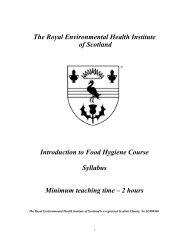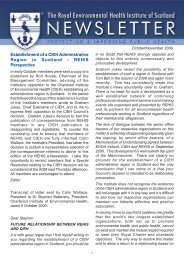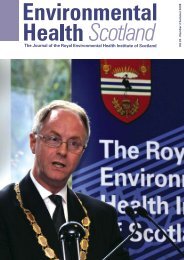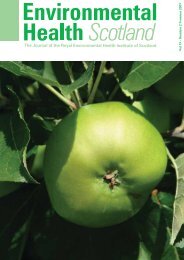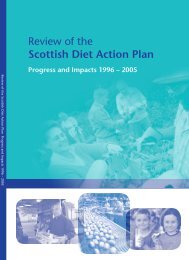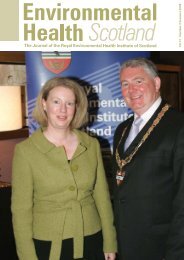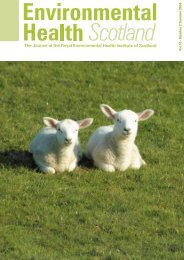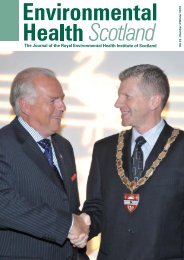Download REHIS Journal 21/3 (Autumn 2009) - The Royal ...
Download REHIS Journal 21/3 (Autumn 2009) - The Royal ...
Download REHIS Journal 21/3 (Autumn 2009) - The Royal ...
Create successful ePaper yourself
Turn your PDF publications into a flip-book with our unique Google optimized e-Paper software.
Environmental Health Scotland<br />
Figure 5. Predicted NO 2<br />
concentrations in Glasgow, 1998-99 (μg/m 3 ).<br />
Other useful predictor variables included postcodes<br />
within 300m and junctions within 250m. Figure 5<br />
shows the surface of predicted pollution concentrations<br />
for NO 2<br />
in Glasgow, 1998-99.<br />
<strong>The</strong> variables that predicted the highest amount of<br />
variation in pollution concentrations for the BS model<br />
were the road length within 250m of the monitoring<br />
site, the distance to the edge of the urban area and the<br />
altitude (table 2). Other useful predictor variables<br />
were the road length within 50m, junctions within<br />
250m and households within 300m. Figure 6 shows<br />
the surface of predicted pollution concentrations for<br />
BS in Central Scotland, 1970-79.<br />
<strong>The</strong> best model predicted 38% of the variation in<br />
BS concentrations, which means that the BS model<br />
was not very reliable. <strong>The</strong> main problems with this<br />
model were that contemporary road and urban edge<br />
data were used to predict historical BS concentrations<br />
and that the black smoke measurements from the<br />
1970s were incomplete with many extended periods<br />
of missing data. Using contemporary surrogate<br />
emission and advection data was not ideal, but<br />
historical road and urban area data were not available.<br />
Statisticians working on an epidemiological study<br />
on long-term black smoke exposure and mortality<br />
(Beverland et al, 2007) predicted the missing<br />
pollution data using sophisticated imputation methods<br />
(Yap, 2005), which improved the reliability of<br />
the pollution concentrations. However, bivariate<br />
correlations between the BS measurements and each<br />
predictor variable were weak, which in turn led to a<br />
model with poor predictive power.<br />
Ideal conditions for using land use regression modelling<br />
would be when good quality data for pollution<br />
concentrations and predictor variables are measured<br />
during the same time period.<br />
Table 2. Multiple regression model for BS in Central Scotland, 1970-79.<br />
8



